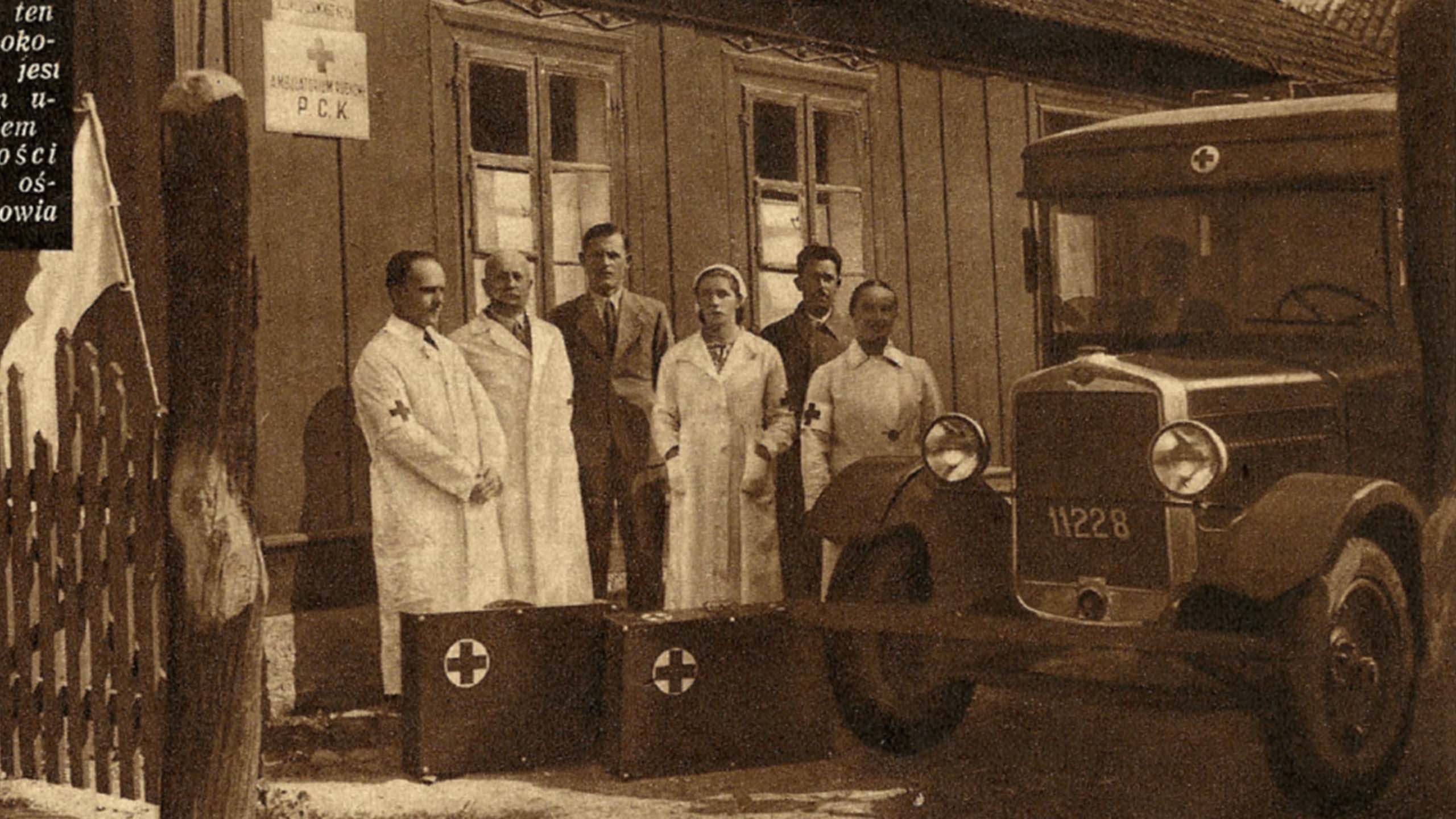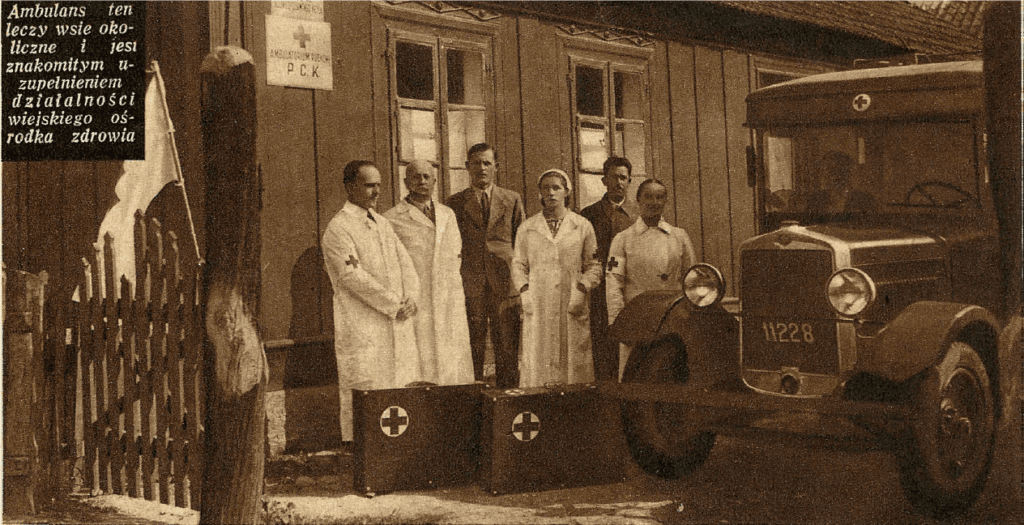The Polish Red Cross was the initiator of health care in rural areas during the interwar period and the establishment of the first rural health centers.

Despite the expansion of the network of health centers by the state and local governments, as well as the Social Insurance Institution, the residents of the village acutely felt the lack of medical care. The idea of creating health centers in villages came from Countess Maria Tarnowska, Vice President of the Polish Red Cross, who was a trained nurse by profession.
Living in the Świerże estate in Lublin Voivodeship, she provided nursing and hygiene advice to the residents of her village. At that time, she was horrified by the dire living conditions and the backwardness of the rural population (trust in grandmothers, folk healers, and various charlatans), especially regarding child-rearing and hygiene. Thus, she proposed the project of organizing a network of rural health centers throughout the country under the auspices of the Red Cross. By promoting this idea, she wrote articles in the press and delivered radio talks. The project actually gained substantial support. The first rural health center was established in the Tarnowski estate in Świerże. They allocated one of the residential buildings for administration, equipped it, and provided water and electricity.
In the period leading up to 1939 in Poland, the Red Cross, modeled on the center in Świerże, launched about 300 such facilities. Today we could say that the establishment of rural health centers was an excellent example of partnership between estate owners, local governments, and the Polish Red Cross. The local facilities were provided by the commune or private owners, and the National Board of the Polish Red Cross dispatched a qualified nurse to work at the center and covered her salary. In the Małopolska region, Zakliczyn was an example of such a center. In 1938, 110 children were registered at the center, 191 people in the anti-jacobite clinic, and 248 in the anti-tuberculosis clinic. There were also clinics for counter-venereal diseases and a clinic for mothers. In total, 4588 consultations were provided at the rural center in 1938.
In cooperation with state and local government offices, so-called "flying health centers" were also established, which were also run by the Red Cross. The areas for their establishment were localities that had no medical care. To each of them, a doctor arrived once a week equipped with medicines and treated the sick for 5-7 hours a day. Nurses and hygienists accompanied the doctors. The "flying health centers" were operated by the communes, which also covered the costs of maintaining these premises. These centers primarily engaged in preventive activities. The centers focused on schoolchildren's care, with each child to be examined at least once a year.
In the campaign to spread sanitary education in the countryside, popularize hygiene principles for daily life, and combat folk healing during the interwar period, the Polish Red Cross made a significant contribution. They also trained so-called rural health leaders. These were village girls educated in Red Cross courses with the thought that upon returning to the village, they would provide first aid in emergencies and contribute to improving the health status of village residents through conducted campaigns.

Facts about the Polish Red Cross
Only after the fourth request to the International Red Cross was the Polish Red Cross recognized on the international stage.
The beginnings of blood donation in the Red Cross date back to 1935, which took place 83 years ago.
If the borders of Poland had not been changed after World War II, the 100th anniversary of the Polish Red Cross (PCK) would have been celebrated with the Lviv, Volhynian, and Wilno branches, which are still active today but under the structures of different state associations.
The employees of the Polish Red Cross carried out the exhumation of Polish officers murdered in the Katyn Forest while also being responsible for creating the official Katyn Lists
The Red Cross movement and its foundations were the source for the establishment of sanitary services for wounded soldiers under the names Polish White Cross and Polish Green Cross.
Over the years, the rules for statutory financing of the PCK's activities have changed, as has our role and position within the state.
The PCK enjoyed immense public trust during the Second Polish Republic, and the most important figures in the state always spoke about our organization with the utmost respect.
To this day, in Tarnów, Małopolska, there is a nearly 100-year tradition of parades through the city organized on the occasion of the Polish Red Cross Week.
On February 8, 2018, it was 50 years since the establishment of the badge of the Honorable Blood Donor
On February 8, 2018, it marked 50 years since the establishment of the badge of the Meritorious Honorary Blood Donor
PCK never accepted any gratifications and did not support the Nazi authorities, thereby exposing itself to severe consequences.
The Polish Red Cross was the initiator of healthcare in rural areas during the interwar period and the establishment of the first village health centers.
PCK was involved in the construction of the Marshal Piłsudski Mound in Sowińca in Krakow in 1936
At the beginning of 1919, within the structures of the newly established Polish Red Cross Society, 3 District Branches of the PTCK were created: for Galicia, the Grand Duchy of Posen, and Silesia.
During its 100-year activity, the Polish Red Cross, the International Committee of the Red Cross, honored 102 Polish nurses associated with our organization with the Florence Nightingale Medal.
The Polish Red Cross was the organizer of parachuting courses
Did two Polish doctors working at the Red Cross hospital during World War II save more lives than Oskar Schindler?
There existed simultaneously the Polish Red Cross and the Polish White Cross, whose president was Helena Paderewska.
There was a time in the history of PCK when, legally, two or even three Main Boards of PCK operated simultaneously.
Help us endlessly
Thanks to the kindness and support of our Donors, we can help children, seniors, support medical rescuers, promote the idea of blood donation, and implement many other projects that save lives in times of conflict or humanitarian crises. Every donation and every form of support is significant because the Polish Red Cross connects those in need with those who want to provide help. Let’s help together!
See also
08. PCK was involved in the construction of the Marshal Piłsudski Mound in Sowińce, Kraków in 1936.
In 1934, the Legionnaires' Association was founded in Kraków and took the initiative to create a commemorative mound, which serves as a monument to the struggles for Independence. At the head of the Committee for the Construction of the Mound, established in Warsaw, was Walery Sławek.
10. The PCK never accepted any rewards and did not support the Nazi authorities, thereby exposing itself to severe consequences.
The PCK during the Second World War was engaged on a large scale in organizing aid for the civilian population, while simultaneously dealing with many difficulties, mainly financial and harassment from the German authorities.
You are currently viewing a page filtered by content from the department. Cała PolskaIf you want to view content from Cała Polskaclick the button